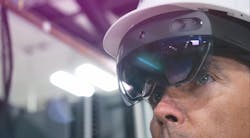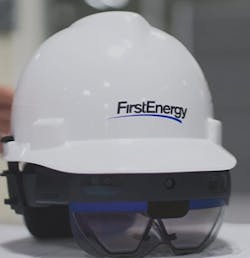Augmented Reality Transports FirstEnergy Field Workers into the Future
As part of FirstEnergy’s ongoing efforts to deliver safe and reliable power to customers into the future, the company monitors emerging technologies that can help make field work safer and more efficient. One of the new technologies being explored is a state-of-the-art headset that superimposes computer-generated images onto the view of the user through what’s known as augmented reality.
Like holograms in a sci-fi movie, the headset’s augmented reality functionality layers digital assets like images and videos on top of what the user sees in the field. This could include instructions, support materials and other resources referenced to complete a job. The user can open, move or close each item from a menu using a finger or hand to navigate.
To discover how this could make field work more efficient for workers — and enhance service reliability for customers — several FirstEnergy field engineers are utilizing the headsets as part of their work conducting proactive maintenance in substations, which serve as hubs for distribution of electricity into communities and neighborhoods.
A Remote Reality Realized
The augmented reality headsets are used with a software application that provides a platform where a technician using the headset can communicate with a remote expert using live video calling. Augmented reality allows the remote expert and the field engineer to share the same view through the lens, digitally notate items in the physical environment, and send data files and photos to and from the field engineer’s view. Augmented reality combined with live video allows the team to troubleshoot problems together, faster.
“Remote employees can see everything through the eyes of the employee on site, allowing them to provide direct, real-time feedback and guidance to the field employee,” said Gene Altenburger, Transmission and Substation Services commissioning supervisor and pilot participant. “Using the headset, remote experts can virtually go to work sites without physically being there.”
During a recent project, an unknown issue in a substation was quickly identified after a field engineer using the headset connected with remote experts for assistance. This allowed field employees to make repairs proactively, while eliminating the need for multiple workers to travel to the substation.
“With our use of the headsets in the field, we’re finding that we are able to get input from remote experts much faster than traditional methods of remote communication,” said Greg Kowalski, a FirstEnergy engineer and pilot participant. “The input isn’t only faster, but more interactive and instructive.”
Peering into the Future
Two augmented reality headsets are currently in use as part of the pilot program. If the pilot continues to yield positive results, the goal is to roll out additional headsets for more teams to use. Leaders are also considering ways in which this technology can be implemented in other areas of the company.
“The benefits of augmented reality are apparent and applicable to many departments at FirstEnergy,” said John Martinez, director of Transmission and Substation Services. “The technology could potentially be used across the company in a variety of ways, including training and field inspections.”
Through the augmented reality, FirstEnergy has obtained a sneak peek into the future of energy. By leveraging this device to improve communication, situational awareness and human performance the sky is the limit for how employees can work faster and safer to deliver the power customers rely on every day.


